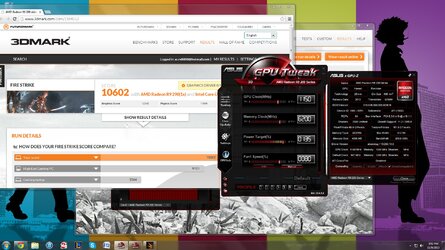- Joined
- Jun 7, 2011
I play many games at 30 FPS (mainly on console) and some of them was a better gaming experience than any of the 100 FPS PC games i ever had. A game isnt becoming good with FPS, its becoming good with gameplay and a common sense by a clear margin. Im not even sure if those people truly enjoy gaming, prehaps what they truly enjoy is how cool the machine is running them.
I remember, when i was very young i was unable to afford a good PC, and some games was running at 20 FPS but i had lot of fun, no matter how bad the PC did perform... i was just happy that my machine was able to run the game at all. Performance was out of range, but gameplay was always with me and joy too. So, unfortunately i dont agree with you.
In term anyone would stop playing a game at 40 FPS, a nice and very playable value, i think its not a real gamer but thats my own mind, other people may have other terms for "real gamers" but i wont change my own term because with all my heart and soul i know myself, a real game, and my joy. I know houndreds of RPGs and other games from around the world on more than ten systems and i feel i had more joy playing them at "bad" performance than 10 of the "high performance" gamers added together.
In term of Tomb Raider, just need to disable TreesFX and the FPS will eat breakfast. The loss of that eyecandy is actually low, its not the stuff making a good game out of it, just a marginal eye candy trying to bust up the hardware... (loss of half the FPS, just for hair simulation, thats terribly ineffective). Still, i see close to no difference playing it at 40 vs. 60 FPS because as long as the game is bad, it wont even rock at 1000 FPS, performance will be no use at all. However, I enjoy Skyrim at 40 perfectly fine, 60 is even better but the difference in joy is just marginal, a RPG doesnt need insane FPS, all it takes is a great game and a lot of fantasy.
Actually, anything above 100 FPS is waste of time even to speak about. I dont think there is any human able to tell the difference between 100 and 1000 FPS, if so, its just belong to theyr own believes, but not a proven fact. Most humans cant even tell the difference between 100 and 60 FPS because 60 is close to the "perfect value" without any loss in order to deliver a smooth engine. More important than that is a stable FPS without microjudders and sudden drops. I usualy cap my FPS to 60 because any value higher than that is no use to me, its just stressing the hardware for no reason.
I remember, when i was very young i was unable to afford a good PC, and some games was running at 20 FPS but i had lot of fun, no matter how bad the PC did perform... i was just happy that my machine was able to run the game at all. Performance was out of range, but gameplay was always with me and joy too. So, unfortunately i dont agree with you.
In term anyone would stop playing a game at 40 FPS, a nice and very playable value, i think its not a real gamer but thats my own mind, other people may have other terms for "real gamers" but i wont change my own term because with all my heart and soul i know myself, a real game, and my joy. I know houndreds of RPGs and other games from around the world on more than ten systems and i feel i had more joy playing them at "bad" performance than 10 of the "high performance" gamers added together.
In term of Tomb Raider, just need to disable TreesFX and the FPS will eat breakfast. The loss of that eyecandy is actually low, its not the stuff making a good game out of it, just a marginal eye candy trying to bust up the hardware... (loss of half the FPS, just for hair simulation, thats terribly ineffective). Still, i see close to no difference playing it at 40 vs. 60 FPS because as long as the game is bad, it wont even rock at 1000 FPS, performance will be no use at all. However, I enjoy Skyrim at 40 perfectly fine, 60 is even better but the difference in joy is just marginal, a RPG doesnt need insane FPS, all it takes is a great game and a lot of fantasy.
Actually, anything above 100 FPS is waste of time even to speak about. I dont think there is any human able to tell the difference between 100 and 1000 FPS, if so, its just belong to theyr own believes, but not a proven fact. Most humans cant even tell the difference between 100 and 60 FPS because 60 is close to the "perfect value" without any loss in order to deliver a smooth engine. More important than that is a stable FPS without microjudders and sudden drops. I usualy cap my FPS to 60 because any value higher than that is no use to me, its just stressing the hardware for no reason.
Last edited:

